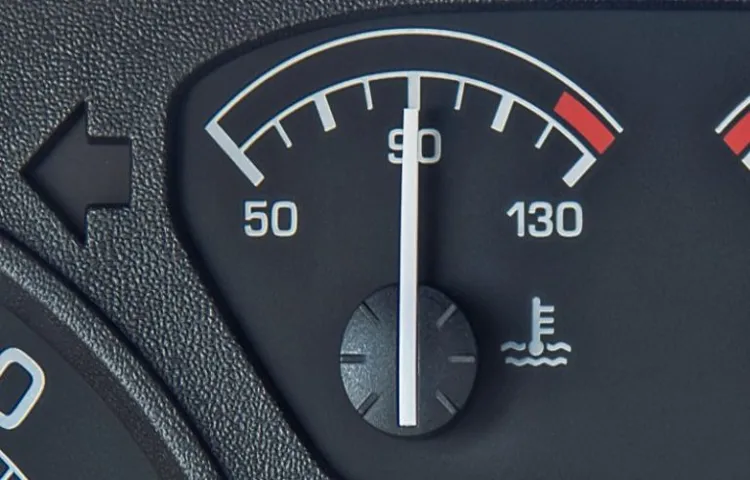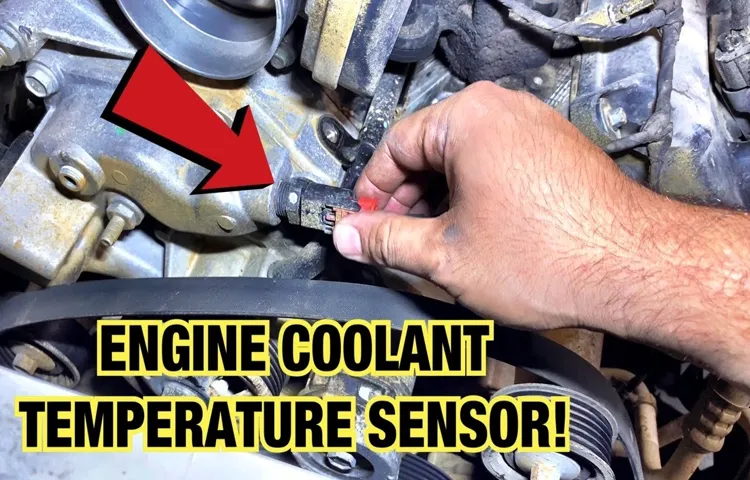Have you ever been driving along in your car, only to notice that the temperature gauge is creeping toward the red zone? It’s a nerve-wracking sight, and it’s natural to wonder if your engine is about to overheat. But what coolant temperature is too high? And what should you do if it happens? In this blog post, we’ll delve into the world of engine temperatures and discuss how to handle a coolant temperature that’s off the charts. So buckle up and get ready to learn all about the optimal temperature for your vehicle’s engine and what to do if things start to get too hot under the hood.
Table of Contents
What is coolant temperature?
Have you ever been driving along and noticed that your car’s temperature gauge is creeping up into the red zone? Well, that’s a sure sign that your coolant temperature is too high. But what exactly does that mean? The coolant temperature refers to the temperature of the liquid coolant that circulates throughout your engine to help regulate its temperature. It’s essential to keep this temperature within a certain range to prevent your engine from overheating and potentially causing serious damage.
So, what coolant temp is too high? Well, there isn’t a definitive answer as it can vary depending on the make and model of your vehicle. However, as a general rule, if your coolant temperature reaches above 240 degrees Fahrenheit, that’s considered too high and you should take immediate action to cool it down. This could include pulling over and letting your engine cool off, checking for any coolant leaks, or even contacting a professional mechanic for assistance.
It’s always better to be safe than sorry when it comes to your engine’s temperature, so keep an eye on that gauge and take action if necessary.
Definition of coolant temperature
Coolant temperature refers to the temperature of the coolant fluid that is circulating through the engine of a vehicle. This fluid plays a crucial role in regulating the temperature of the engine and preventing it from overheating. The coolant temperature is usually measured by a sensor located near the engine or in the radiator.
It is essential to keep track of the coolant temperature as it can indicate if the engine is running too hot or too cold, which can lead to various issues. If the coolant temperature is too high, it may be a sign of a cooling system malfunction, such as a faulty thermostat or a blocked radiator. On the other hand, if the coolant temperature is too low, it can result in poor fuel efficiency and increased engine wear.
Monitoring the coolant temperature can help prevent engine damage and ensure optimal performance.

Importance of maintaining proper coolant temperature
coolant temperature, maintain proper coolant temperature
What is considered a high coolant temperature?
What is considered a high coolant temperature? Well, when it comes to your vehicle’s coolant temperature, there is a range that is considered normal, and anything outside of that range could be cause for concern. Generally, a coolant temperature of 190-220 degrees Fahrenheit is considered normal for most vehicles. However, if your coolant temperature exceeds 220 degrees Fahrenheit, that could be a sign that your engine is running too hot.
This could be due to a variety of factors such as a malfunctioning thermostat, a coolant leak, or a problem with the radiator or cooling system. It’s important to address high coolant temperatures promptly to prevent engine damage and ensure the longevity of your vehicle. So, if you notice that your coolant temperature is consistently running high, it’s best to have your vehicle inspected by a qualified mechanic.
They can diagnose the issue and get your coolant temperature back within the normal range.
Standard operating range for coolant temperature
coolant temperature, high coolant temperature, standard operating range, engine overheating, cooling system, radiator, thermostat, coolant levels The coolant temperature in a vehicle plays a crucial role in ensuring the engine operates at an optimal level. The standard operating range for coolant temperature typically falls between 195 to 220 degrees Fahrenheit (90 to 105 degrees Celsius). However, what is considered a high coolant temperature? Well, if the temperature exceeds the upper limit of the standard operating range, it can be a sign of engine overheating.
This can result in a variety of issues such as damage to engine components, reduced fuel efficiency, and even complete engine failure if left unchecked. To prevent this, it is important to monitor the coolant temperature gauge and keep an eye out for any signs of overheating such as steam or smoke coming from the engine bay. If the coolant temperature consistently rises above the standard operating range, it is crucial to address the issue promptly to avoid any long-term damage.
This may involve checking and replenishing coolant levels, ensuring the radiator and cooling system are free from blockages, and inspecting the thermostat for any malfunctions. By maintaining the coolant temperature within the recommended range, you can ensure the longevity and performance of your vehicle’s engine.
Factors that can affect coolant temperature
How to prevent high coolant temperatures?
Potential risks of high coolant temperature
The potential risks of high coolant temperature can have serious consequences for your vehicle. But what exactly is considered a high coolant temperature? Typically, a normal operating range for coolant temperature is between 195°F and 220°F (90°C and 105°C). If your engine starts to exceed these temperatures, it can lead to a variety of issues.
One of the primary risks is the potential for engine overheating, which can cause major damage to your engine components. This includes things like blown head gaskets, warped cylinder heads, and cracked engine blocks. Additionally, high coolant temperatures can also lead to decreased performance and fuel efficiency.
The higher the temperature, the harder your engine has to work to maintain its operation. This can result in decreased power and increased fuel consumption. It’s important to monitor your coolant temperature regularly and address any issues as soon as they arise to avoid these potential risks and keep your engine running smoothly.
Signs of an overheating engine
Have you ever wondered what temperature your coolant is supposed to be at? It’s important to keep an eye on your engine temperature to prevent it from overheating. If your coolant temperature gets too high, it can cause serious damage to your engine. So, what is considered too high? Well, it really depends on your specific vehicle, as different engines have different operating temperatures.
However, a general rule of thumb is that if your coolant temperature surpasses 220 degrees Fahrenheit (104 degrees Celsius), it’s a sign that your engine is running too hot. If you notice your temperature gauge creeping into the danger zone, it’s important to take action immediately. Pull over, turn off your engine, and let it cool down before assessing the issue.
It could be something as simple as a low coolant level, or it could be a more serious problem like a malfunctioning thermostat or a leaky radiator. Either way, it’s crucial to address the issue promptly to avoid further damage to your engine. So, remember to keep an eye on your coolant temperature and stay vigilant to signs of an overheating engine.
Visual indications of overheating
Overheating can be a serious issue for your car’s engine, and it’s important to address it as soon as possible. But how do you know if your engine is overheating? Well, there are a few visual indications that can clue you in. One of the most obvious signs is if you notice steam coming from under the hood.
This is a clear indication that your engine is overheating and needs immediate attention. Another visual sign is if you see the temperature gauge on your dashboard reading in the red zone. If this happens, it’s important to pull over and turn off your engine to prevent further damage.
Additionally, you may notice a sweet smell coming from your engine, which could be a sign of coolant leaking. It’s important to address any signs of overheating promptly to prevent costly repairs down the line.
Performance issues caused by high coolant temperature
overheating engine, high coolant temperature, performance issues. The last thing any car owner wants is an overheating engine. Not only is it a major inconvenience, but it can also cause serious damage to the vehicle.
So, how do you know if your engine is overheating? Well, there are a few signs to look out for. First, you may notice that the temperature gauge on your dashboard is in the red zone or higher than normal. This is a clear indication that your engine is running too hot.
Another sign is steam or smoke coming from under the hood. This could be a result of coolant boiling over from the high temperatures. You might also experience a loss of power or performance.
When the engine gets too hot, it can cause the components to expand, leading to friction and increased resistance. This can result in sluggish acceleration and poor overall performance. If you notice any of these signs, it’s important to address the issue right away.
Ignoring an overheating engine can lead to more serious and costly repairs down the line. So, if your car is running hot, be sure to have it checked out by a trusted mechanic.
Warning lights and indicators
Overheating can be a real nightmare for your engine, and it’s important to know the signs so you can take action before any serious damage occurs. A common warning light for an overheating engine is the temperature gauge. This gauge measures the temperature of the coolant in your engine and lets you know if it’s getting too hot.
If you see the gauge creeping into the red zone, it’s time to pull over and let your engine cool down. Another indicator of an overheating engine is steam or smoke coming from under the hood. This is a clear sign that something is not right and you should immediately turn off the engine and call for assistance.
Finally, a strange smell, like burning rubber or coolant, can also indicate an overheating engine. If you notice any of these signs, it’s best to play it safe and have your engine checked by a professional. Ignoring the warning signs could lead to costly repairs or even a complete engine failure.
So, remember to keep an eye out for these signs and take action as soon as you notice them. Your engine will thank you!
What to do if your coolant temperature is too high
If you notice that your coolant temperature is too high, it’s important to take action to prevent any potential damage to your vehicle’s engine. The ideal coolant temperature for most cars is around 195 to 220 degrees Fahrenheit. Anything above this range could indicate a problem with your cooling system.
There are a few things you can do if you find yourself in this situation. First, check your coolant level and make sure it’s at the correct level. If it’s low, you may need to top it off or have a coolant leak repaired.
Next, check for any obstructions in your radiator or cooling system. Over time, debris can build up and hinder the efficiency of your cooling system. If you notice any blockages, it may be necessary to flush the system or have it professionally cleaned.
Additionally, you should check your radiator fan to ensure that it’s functioning properly. A faulty fan can prevent the coolant from being cooled properly, leading to higher temperatures. If your coolant temperature remains too high despite these steps, it’s best to have your vehicle inspected by a qualified mechanic who can diagnose and repair any underlying issues.
Immediate actions to take when coolant temperature rises
If you notice that the coolant temperature in your vehicle is rising, it is important to take immediate action to prevent any further damage to your engine. One of the first things you should do is pull over to a safe location and turn off the engine. This will help to prevent any further overheating and potential damage.
Once the engine is turned off, you can pop the hood and check the coolant level. If it is low, you can add more coolant to the reservoir but make sure to wait until the engine has cooled down before opening the radiator cap. In addition to checking the coolant level, you should also check for any visible leaks or damage to the hoses or radiator.
If you notice any leaks, it is best to have them repaired by a professional as soon as possible. If the coolant level is fine and there are no visible leaks, the issue may be with the thermostat or water pump. In this case, it is recommended to contact a mechanic for further assistance.
Remember, it is important to address high coolant temperatures as soon as possible to avoid any costly repairs or engine damage.
Long-term solutions for managing coolant temperature
coolant temperature, managing coolant temperature, high coolant temperature
Preventing high coolant temperature
We all know that a car’s engine can get hot, but how hot is too hot when it comes to coolant temperature? Well, the answer to that question depends on several factors. The optimal operating temperature for most cars is around 195 to 220 degrees Fahrenheit (90 to 105 degrees Celsius). However, if your coolant temperature starts climbing above 220 degrees Fahrenheit (105 degrees Celsius), it may be a sign of a problem.
When the coolant temperature gets too high, it can cause a slew of issues, including engine overheating, radiator damage, and even engine failure. So, it’s important to keep an eye on your coolant temperature gauge and take action if it starts creeping up too high. Regular maintenance, such as checking and replacing coolant as needed, can help prevent high coolant temperature and keep your engine running smoothly.
Regular maintenance and inspections
Regular maintenance and inspections are crucial for preventing high coolant temperature in your vehicle. Over time, coolant can become contaminated with dirt, debris, and other impurities, which can lead to poor heat transfer and ineffective cooling. By regularly flushing and changing the coolant, you can ensure it remains clean and capable of regulating engine temperature.
Additionally, it is important to inspect the cooling system components, such as the radiator, hoses, and thermostat, for any signs of wear or damage. These parts play a vital role in maintaining proper coolant circulation and minimizing the risk of overheating. By keeping up with routine maintenance and inspections, you can catch any potential issues early on and prevent the coolant temperature from reaching dangerous levels.
So, don’t overlook the importance of regular maintenance when it comes to your vehicle’s cooling system.
Monitoring coolant levels and condition
One important aspect of vehicle maintenance is monitoring the coolant levels and condition. Coolant plays a vital role in regulating the temperature of the engine, preventing it from overheating. High coolant temperature can lead to serious engine damage and costly repairs.
By regularly checking the coolant levels, you can ensure that there is enough coolant in the system to effectively cool the engine. Additionally, it is important to monitor the condition of the coolant. Over time, coolant can become contaminated with debris and lose its effectiveness.
By regularly inspecting the coolant, you can detect any signs of contamination or degradation and address the issue before it causes any problems. Taking the time to monitor coolant levels and condition can save you from major headaches down the road and keep your engine running smoothly.
Proper use of coolant additives
coolant additives, high coolant temperature
Conclusion
When it comes to coolant temperature, it’s all about finding that perfect balance. Just like in life, too high of a temperature can lead to disastrous consequences. Picture this, you’re sitting in a sauna, but instead of feeling rejuvenated, you start to feel like a sizzling sausage on a stove.
That’s exactly what happens to your engine when the coolant temperature rises to dangerous levels. But how do you know when the coolant temperature is too high? Well, listen up my friend, because I’m about to give you the inside scoop. When the temperature gauge starts climbing faster than a mountain goat on Red Bull, you know it’s time to take action.
If you dare to ignore it, you’re playing a risky game with your engine’s well-being. Think of coolant temperature as a delicate dance between the engine and the coolant; too high and it’s like throwing a Molotov cocktail at a birthday cake – things are going to get explosive. High temperature can lead to overheating, which can cause major damage to your engine’s vital components.
It’s like trying to march through a desert without a sip of water – the engine is going to go on strike and leave you stranded. So, my dear reader, keep a close eye on that temperature gauge. If it starts creeping into the danger zone, it’s time to take swift action.
Pull over, pop the hood, and give your engine a chance to chill out. And remember, just like in life, it’s always better to err on the side of caution when it comes to coolant temperature. Stay cool, my friend, and keep that engine purring like a contented cat.
“
FAQs
What is the ideal coolant temperature for a car engine?
The ideal coolant temperature for a car engine is usually between 195-220 degrees Fahrenheit.
How can I tell if my coolant temperature is too high?
You can tell if your coolant temperature is too high if you notice the temperature gauge on your dashboard is in the red zone, if you see steam coming from under the hood, or if you smell a sweet and/or burning odor.
What can cause a car’s coolant temperature to rise too high?
There are several possible causes for a car’s coolant temperature to rise too high, including a coolant leak, a malfunctioning radiator, a faulty thermostat, a blocked radiator, or a malfunctioning cooling fan.
What are the dangers of driving with a coolant temperature that is too high?
Driving with a coolant temperature that is too high can lead to serious engine damage, such as a blown head gasket, warped cylinders, or even a cracked engine block.
What should I do if my coolant temperature is too high?
If your coolant temperature is too high, you should immediately pull over to a safe location, turn off the engine, and allow it to cool down. Avoid opening the radiator cap while the engine is still hot, as it can cause scalding hot coolant to spray out.
How can I prevent my coolant temperature from getting too high?
To prevent your coolant temperature from getting too high, make sure to regularly check and maintain your coolant levels, inspect the radiator for any leaks or blockages, replace the thermostat if necessary, and ensure that the cooling fan is functioning properly.
Can extreme weather conditions affect the coolant temperature?
Yes, extreme weather conditions can affect the coolant temperature. In hot weather, the engine may run hotter, and in cold weather, the coolant may take longer to warm up. It’s important to monitor the coolant temperature and adjust your driving accordingly in extreme weather conditions.



